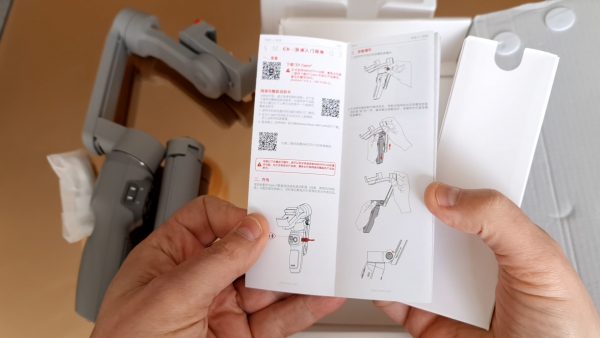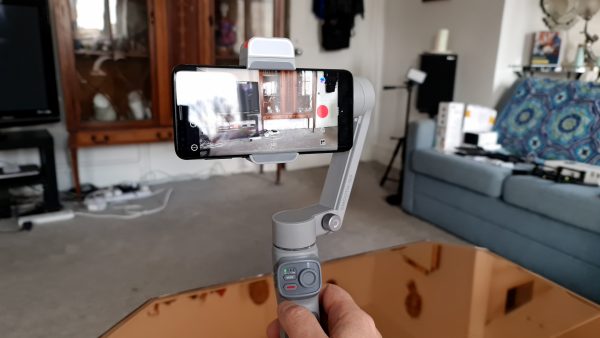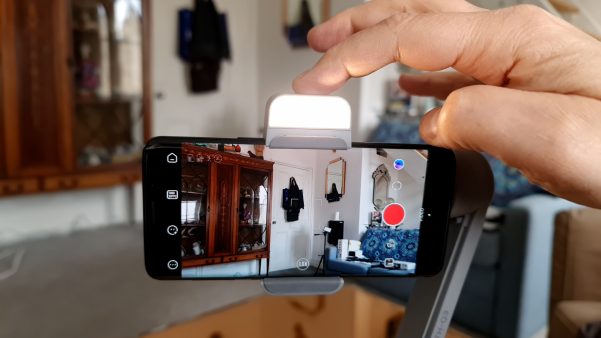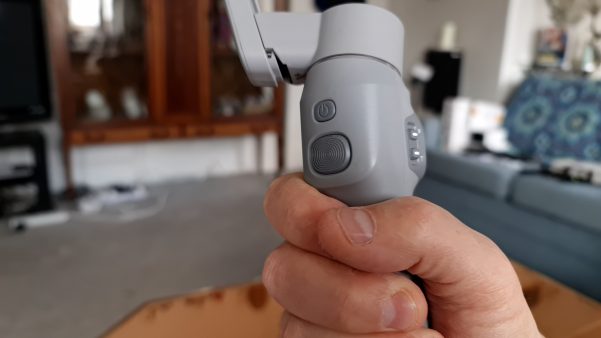Zhiyun Smooth Q3 – Review
Zhiyun sent me their new gimbal to try out – the Smooth Q3. My first ever gimbal was the original Smooth Q and I shot 5 short films with it. Then came the Smooth Q2, which was very different to the original Smooth Q and, honestly, not my favourite gimbal.
But, I’m sure the Zhiyun team have been working hard on this. So let’s see what we think of the Smooth Q3.
Zhiyun Smooth Q3 – First Impressions
There’s not too many extras in the sample box – just the gimbal, a mini tripod, cable, paper manual. This is just the test model from Zhiyun and I believe it will ship with a protective bag and wrist strap as well.
As soon as I took it out of the box, I noticed the gimbal is very light in the hand. I’d also say this handle is made for small hands. It’s ok, but I did notice as soon as I held it.
Next thing I noticed that’s a bit different is the way this gimbal doesn’t fold, like the OM 3 and OM 4, Vlog Pocket, Moza Mini and some others. Instead, it extends.
Unlock the arm with screw-lock and slide it until it clicks into place. Now tighten the screw-lock again. Then you need to unlock the 2nd motor.
There is a bit of balancing that needs to be done first. If it’s not balanced correctly, it will still work but will consume more battery power and weaken the motor strength.
That’s it – power on and off you go.
Basic Controls
There’s a joystick, as we would expect. It’s sensitive to how far you push it, so if you push it a little bit, it moves slower than if you push it all the way.
The red long button is simply the record button. Then there’s a mode button, with an indicator to show you which mode the gimbal is in. So that’s nice, that you don’t have to go into the app settings.
At the side we have the usual zoom control. This doesn’t look too smooth, at least on my Samsung S9. I will try it on my other phones later.
One tap of the trigger starts object tracking. 2 taps centres the gimbal. So that’s the basic controls. OK, let’s get this thing working.
Modes
There’s 6 different modes: Pan Follow, Follow, Lock, POV (point of view), V (vortex) and GO mode. I don’t think any of these are new. If you have a Zhiyun gimbal, you probably know these modes already.
New Features
Now, this is something I haven’t seen before. They’ve put a light onto the top of the clamp for vlogging. Normally, we would have to mount a light to the gimbal somehow.
To turn the light on, just hold your finger on the top for a couple of seconds. Then tap to switch between 3 different brightness levels. The temperature of the light is 4300 kelvins, which is a strong white, or daylight colour.
You can also turn the light to face away from you, perhaps if you’re filming another subject.
The light also helps you to know which way up the clamp goes when you mount your phone. The light is at the top and the camera on your phone to the left.
New: Smartfollow 3.0
With the new SmartFollow 3.0, you just need to aim the target in the App and tap the trigger once. The gimbal enters Locked mode and the camera locks onto whatever object is in the square. Tap once again, to exit Smartfollow and back to Pan Follow mode.
Smooth Q2 vs Smooth Q3 vs DJI OM 4
The Smooth Q3 is quite a bit lighter compared to the Q2. The Q2 is 440 grams whereas the Q3 is 100 grams less at 340 grams. In terms of weight it can cope with, the Q3 is just a bit better with a max payload of 280 grams, compared to 260 grams for the Q2.
Now compared to the DJI OM 4, the DJI is a bit heavier at 390 grams and has about the same max payload. DJI says the OM 4 can carry up to 290 grams, so that’s only 10 grams more.
Now, my iPhone 12 Pro Max weighs 230 grams, which is fine. But if I add a case and a lens, that goes up to 312 grams. So that’s going to be over the maximum recommended payload. So, for that kind of setup you will be working at the limits of the gimbal’s motors.
One of the things I didn’t like about the Smooth Q2 was switching from portrait to landscape. It was just really awkward. To be honest, it didn’t work. On the Smooth Q3, it’s just 3 quick trigger pulls and it works perfectly.
Smooth Q2: Tilt:305° Roll:265° Pan:360°
Smooth Q3: Tilt:340° Roll:340° Pan:300°
DJI OM 4: Tilt: 341° Roll: 130° Pan 331°
Smooth Q3 Design
The power up button is on the front of the handle, above the trigger. Again, that’s a bit different.
Also, the tigger itself is flat. And that’s so the arm can slide down when you want to make it smaller again. It might take a bit of getting used to finding the buttons without turning the gimbal.
Power on by holding the power button down for a couple of seconds. Triple tap the tigger to switch from portrait to landscape.
Zhiyun says that many of the advantages of this gimbal are contained within the app that comes with the gimbal. They’ve linked me to a beta version of the ZY Cami App. It connected to my Samsung S9, no problem.
Different devices may vary but on my Samsung S9, the app allows me to shoot up to 4K and up to 60fps, as well as 30fps and 24fps. Other than that, there’s not too much manual control. You can set white balance, though.
The ZY Cami app comes with SMART mode, which is a series of preset templates. Shoot a few shots and the app will add auto camera movements, then edit it all together with music. Having tested it, this is very much like Story Mode in the DJI Mimo app.
Advanced App Features
Zhiyun says that one big selling point of this gimbal is its advanced app features. So what are they offering?
There’s AILive, there’s more SMART video templates, there’s online editing, and a ZY Remo Assistant. Some features come under what they are calling “Prime Privileges” and these will require a yearly subscription.
Zhiyun says that will be $22.49 (excl VAT) in America and €22.49 EUR (incl VAT) in Europe. However, at first they will offer 6 months free to those who sign up.
So what are these features?
First, there’s AILive, which allows you to use the face-tracking feature whilst broadcasting live, via your regular social media platforms.
There’s also online editing, which allows you to use templates to quickly cut your shots together. Zhiyun are aiming this for TikTokers, Instagrammers, vloggers, so this is all about delivering fun and exciting content, in a fast and convenient way.
Actually, many of these things come with the app free. There are just a few features (where you see this crown symbol) which are part of the premium package.
ZY Remo Assistant allows you to use a second phone (plus ZY Remo) to remotely control and monitor your main device and the gimbal. This is a bit like FiLMiC Remote, so if you have a 2nd device it could be quite useful (Note, since I wrote this review, Zhiyun have decided to delay the release of te Remo app until they have ironed out a few bugs).
This will allow you to use a 2nd device to change modes, set timelapses, zoom, start/stop record, and so on. Again, this is very useful for vlogging when most of us are filming alone.
I tested it using my 2 Samsung devices, using the S9 to control the Note 20 Ultra. There’s not too many options. On Android at least, there are 3 options. You have a record button, front to back camera switch and if you tap the screen and drag, you can control the joystick remotely.
I also tested it by controlling my iPhone with my iPad. And it turns out the features are identical.
So you can see, they’re really aiming at vloggers, giving you more options for solo filmmaking.
ZY Cami App: iOS vs Android
The main difference between the ZY Cami app on an iPhone compared to my Samsung, is that you can adjust ISO and shutter speed using manual mode. There’s also a 25fps option when selecting frame rate.
On iPhone, the ZY Cami app allows you to set very slow shutter speeds, as slow as 1/2 a second.
This is useful when shooting hyperlapse videos, if you want the motion blur hyperlapse. So any movement, like cars for example, creates a dramatic blur effect. And this can look really cool.
Buy a Zhiyun Smooth Q3 on Amazon.
Zhiyun Smooth Q3 (official website)
Eager to learn more?
Join our weekly newsletter featuring inspiring stories, no-budget filmmaking tips and comprehensive equipment reviews to help you turn your film projects into reality!
Simon Horrocks
Simon Horrocks is a screenwriter & filmmaker. His debut feature THIRD CONTACT was shot on a consumer camcorder and premiered at the BFI IMAX in 2013. His shot-on-smartphones sci-fi series SILENT EYE featured on Amazon Prime. He now runs a popular Patreon page which offers online courses for beginners, customised tips and more: www.patreon.com/SilentEye








hi I have a q3 smooth and is not connect to the zy cami app any idea